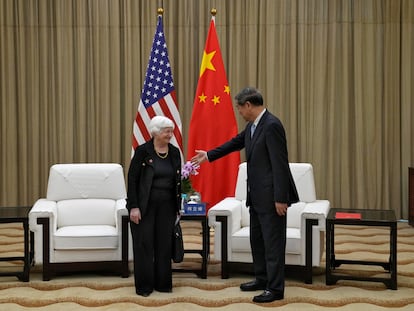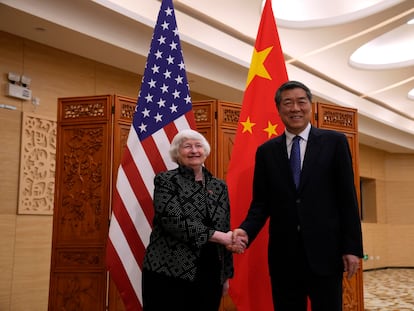A journey to the heart of China’s ‘new productive forces’
Hefei, a city in the east, has become a model to follow for the technological development that Beijing wants to achieve in an economy that has been affected by the real estate crisis

The attendant walks down the aisles to present the most cutting-edge products from a company named iFlytek, one of the darlings of China’s artificial intelligence (AI) industry. There is a small robot dog that walks between exhibition stands, a smart board that aims to transform education, networks for urban traffic management displayed on a LED wall, and an automated arm that never loses at Go, the ancient Chinese strategy board game. The company, founded in 1999, has built its success on a simultaneous interpretation system, widely used in China, which generates a translation almost instantly into more than 80 languages and is practically like going through life with subtitles. Last year, iFlytek launched Spark Desk, an AI tool designed to compete with ChatGPT. At this point, the attendant immerses herself in demonstrations: through a spoken command, she asks the machine to generate a children’s story about a rabbit that travels to space (the animal is “very brave” and encounters aliens); she orders him to recommend where to travel (Paris, “the city of love”); the disembodied intelligence changes its voice and language, solves mathematical problems, manages emails, creates drawings, summarizes news, generates statements, speeches and poems, and translates orders into source code. The company has assured that it already surpasses the GPT model in several fields in Chinese; in English, it matches it in dozens of tasks. And this, under the weight of U.S. sanctions and restrictions on cutting-edge technology linked to the semiconductor sector, is perceived as a triumph in Beijing and at the company’s headquarters.
iFlytek is headquartered in Hefei, the capital of Anhui province, which few people outside of China will have heard of. But Beijing has rushed to organize a trip to this city of 12.5 million residents located in eastern China, because it considers it a model to follow in the advancement of the “new productive forces,” the “in” concept in Beijing right now. Launched in 2023 by President Xi Jinping, the term may have Marxist echoes, but it is projected towards a high-tech future. “The new productive forces mean advanced productivity freed from traditional models of economic growth,” defined the top leader. Although it is still somewhat ethereal in nature, the proposal has set the political guidelines of the recent plenary meeting of the National People’s Congress (the Chinese Legislature). Prime Minister Li Qiang has decreed its development and modernization as the priority for 2024. The propaganda machine has started to spin. And, as a consequence, authorities organized the trip to Hefei, a city in the process of transformation.
A little booklet handed out to reporters upon arrival announces that “investment in science and technology accounts for 17.4% of the expenditure of the city’s general public budget, with an intensity of investment in research and development of 3 .91%.” Another statement says that “according to Nature, Hefei ranks 13th among global research cities, rising seven places in the last three years [just behind Seoul, and above Los Angeles]. The new energy vehicle industry has experienced explosive growth, with production of 746,000 vehicles in 2023, ranking among the top three cities in the country.”
For three days, the normally closed doors of companies linked to new technologies are opened up, reflecting Beijing’s hopes for an economy that has been affected by the real estate crisis and finds itself in a deceleration phase. A bus transports reporters from one place to another, from morning to night; An assembly line for batteries for electric cars is shown; another, of new energy vehicles; an unmanned flying taxi being tested (it looks like a large drone; they do not allow passengers to board at the moment); a green energy project that creates heat, among other things, through geothermal energy; a vending machine with wheels that moves by itself along the road… In addition, the regional cadres of the Communist Party came to sit before the media and took questions that had not been agreed upon in advance. And in another rare occurrence, at company headquarters Chinese managers exposed themselves to microphones without a filter.
—How have U.S. sanctions affected your business in recent years?
Dawei Dan, vice president and chief financial officer of iFlytek, remained unfazed by the cloud of recorders and cameras. He answered, first of all, that sales have increased every year. And he exposed one of the reflections that he conveyed to one of his American lawyers shortly after being included in 2019 on the Entity List that Washington draws up to sanction companies that may pose a threat to national security: “To the ordinary Chinese, the Entity List was like a standard. If a Chinese company was included in it, people perceived it as a genuinely high-tech company.”
A few years ago, when the world was different and the commercial and technological war between the two global superpowers was barely visible on the horizon, iFlytek came to be considered by the Massachusetts Institute of Technology (MIT) as one of the most promising companies in the world. AI. The American institution announced in 2018 a collaboration with iFlytek on several advanced AI projects. But it was forced to cancel them when iFlytek was blacklisted, due to suspicions of the company’s collaboration with the Chinese security apparatus in alleged abuses against the Uyghur minority in Xinjiang. Later, iFlytek would suffer the blow of U.S. restrictions on the use of advanced chips, key to the development of AI. In recent times it has partnered for its development with Huawei, another company sanctioned by Washington.
The Hefei model
The “Hefei model” is known in China. The local government has invested since 2008 in companies making LCD displays chips and electric vehicles almost like a financial fund would. It has a university that is renowned for its science programs, and clusters linked to emerging industries. It is also a microcosm where the great geopolitical struggles of the 21st century can be observed at the factory level. And it allows us to take the pulse of Beijing’s vision in that battle. “The US government’s containment of our technology and research definitely plays a negative role,” responds Zhang Yun, vice director of the provincial Development and Reform Commission, to a question from US National Public Radio, during an appearance in Hefei. “But we will follow the Government’s guidelines [...] to address the problems of international trade.”
Many of the issues raised unfold along similar paths: they touch on the European Union’s de-risking policy, the investigation launched by Brussels into the Chinese electric car sector; the overcapacity of technology industries linked to the energy transition, which could flood — as Washington and European capitals fear — Western markets with Chinese products, aggravating the already battered trade balance.
Janet Yellen, the U.S. Treasury Secretary, met this Sunday with Chinese Prime Minister Li Qiang in Beijing, where she has turned the threat of excess Chinese production of electric vehicles, solar panels and other clean energy products into one of the central themes of her second visit to China in nine months.
“There is a global energy transformation underway, and each country has its own policies to support the necessary industries,” replies Wang Qisui, senior vice president of the battery manufacturer Gotion High Tech. “I want to emphasize that China has already moved beyond the policy-supporting phase and has fully moved into a market-driven phase.” In the opinion of this company’s executives, there should be no “panic” about overcapacity. “There is still a shortage of high-quality products on the market.”
Gotion is one of the Chinese giants of battery production. The Hefei plant has been built in coordination with Volkswagen (an investor in the company) for the German brand’s electric models. Taking photographs is not allowed inside the warehouse. The robotization of the process reaches 95%, and they are still in the growth phase. The company is expected to produce up to 80,000 cells per day, a cell being a plate the size of a chocolate tablet that makes up the batteries (about 200 cells are required per car), according to Konstantin Castan, who is in charge of the plant. Castan has worked for years at Volkswagen, where he was dedicated to combustion engines. Now, at Gotion, he has a vision of what is happening here and in the rest of the world. The Asian giant, he concedes, has become the place to be to produce batteries. They are sector leaders. “Everybody knows it.”
—Do you understand the European Union’s fears?
—I think the Europeans need to accelerate. Also the United States. Now it is a competitive market.
Volkswagen landed in the city in 2017, through a joint venture with a Chinese company. It has opened a factory and a research center, and has different suppliers in the vicinity. The cars produced in Hefei will be aimed at the Chinese market, but also at Europe. One of these is the Cupra Tavascan, an SUV designed and developed at the Seat plant in Martorell, Spain. The fact that reporters were also taken on a tour of foreign companies established in Hefei, such as this one, is a way of reaffirming another of Beijing’s strong ideas this year: its commitment to opening up to international investment, despite claims of an increasingly complicated business environment due to China’s emphasis on national security, its pursuit of technological self-sufficiency and mass production.
The EU and European entrepreneurs in China have been critical of the current situation. “It’s like watching a traffic accident unfold in slow motion,” said Jens Esklund, president of the EU Chamber of Commerce in China, a few weeks ago during the presentation of its report Riskful Thinking: Navigating the politics of Economic Security. The crash has not yet occurred, he added, but it is urgent to take action. “We need to find a balance.”
The Volkswagen factory is an open and aseptic-looking space with hardly any trace of human life. Robotization reaches 96%. There are 1,129 Kuka robots, mechanical arms of enormous strength and millimeter precision that were German property at one point in the past. In 2016, Kuka was acquired by Midea, a Chinese appliance giant, for €4.4 billion. It was one of the leading companies in Europe, and one of the main manufacturers of industrial robots in the world. Its acquisition triggered alarms in the EU about the degree of China’s penetration in strategic sectors. Watching them work, like titanic spiders, raising sparks on the sheet metal of a future electric car from a German company that will be sent to Europe, is hypnotic. Behind each movement of this technological dance one senses the very complex skein of digitalization, globalization and geopolitics.
Sign up for our weekly newsletter to get more English-language news coverage from EL PAÍS USA Edition
Tu suscripción se está usando en otro dispositivo
¿Quieres añadir otro usuario a tu suscripción?
Si continúas leyendo en este dispositivo, no se podrá leer en el otro.
FlechaTu suscripción se está usando en otro dispositivo y solo puedes acceder a EL PAÍS desde un dispositivo a la vez.
Si quieres compartir tu cuenta, cambia tu suscripción a la modalidad Premium, así podrás añadir otro usuario. Cada uno accederá con su propia cuenta de email, lo que os permitirá personalizar vuestra experiencia en EL PAÍS.
¿Tienes una suscripción de empresa? Accede aquí para contratar más cuentas.
En el caso de no saber quién está usando tu cuenta, te recomendamos cambiar tu contraseña aquí.
Si decides continuar compartiendo tu cuenta, este mensaje se mostrará en tu dispositivo y en el de la otra persona que está usando tu cuenta de forma indefinida, afectando a tu experiencia de lectura. Puedes consultar aquí los términos y condiciones de la suscripción digital.
More information
Archived In
Últimas noticias
Most viewed
- Oona Chaplin: ‘I told James Cameron that I was living in a treehouse and starting a permaculture project with a friend’
- Reinhard Genzel, Nobel laureate in physics: ‘One-minute videos will never give you the truth’
- Sinaloa Cartel war is taking its toll on Los Chapitos
- Why the price of coffee has skyrocketed: from Brazilian plantations to specialty coffee houses
- Silver prices are going crazy: This is what’s fueling the rally











































